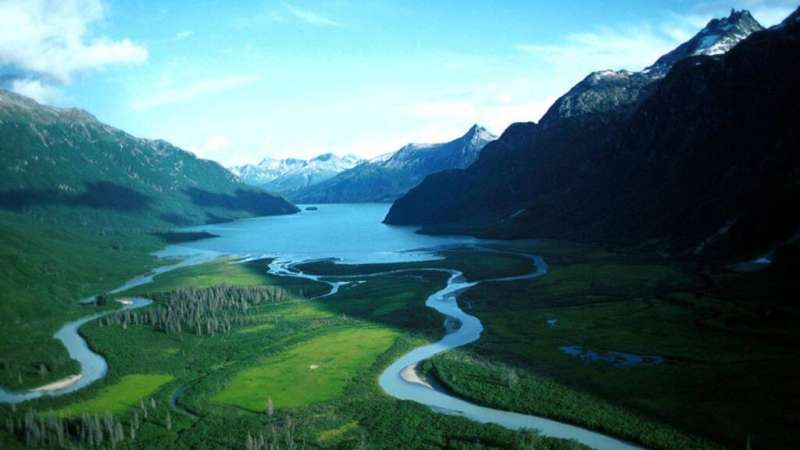The greenhouse gas burden of inland waters
In a new pair of studies, a global team of scientists reassessed greenhouse gas emissions stemming from rivers, streams, lakes, and reservoirs. The studies update previous estimates of greenhouse gas emissions from inland water sources at a global scale.
One decade ago, the Regional Carbon Cycle Assessment and Processes initiative (RECCAP-1) reported that these water bodies could emit as much as 7.7 petagrams of carbon dioxide (CO2) each year. Recently, in a pair of papers by Lauerwald et al published in Global Biogeochemical Cycles, the team introduced the inland water chapter of RECCAP-2. This latest effort synthesizes recent emissions estimates to include two additional greenhouse gases: methane (CH4) and nitrous oxide (N2O).
The first piece reviews state-of-the-art estimates of greenhouse gas emissions from inland waters. The second pairs those estimates with global inland water surface maps to provide regionalized estimates of greenhouse gas emissions.
The study authors found that inland waters contribute 5.5 petagrams of CO2 per year, of which one third emanates from South American rivers. Meanwhile, inland waters emit 82–135 teragrams of CH4 annually, one third of which comes from North American and Russian lakes. N2O emissions were comparatively small at 248–590 gigagrams N2O per year, and a quarter of N2O emissions stem from North American inland waters.
Inland waters could represent approximately 20% of the total global CH4 emissions, the authors found. In contrast, the contributions of inland waters to the global CO2 and N2O budgets are relatively minor.
These estimates are conservative because they do not include ephemeral water bodies, small wetlands, and water bodies smaller than 0.1 square kilometer, the authors say. Nevertheless, the results will improve climate models and global greenhouse gas budgets while spotlighting natural systems’ roles in climate change.
More information:
Ronny Lauerwald et al, Inland Water Greenhouse Gas Budgets for RECCAP2: 1. State‐Of‐The‐Art of Global Scale Assessments, Global Biogeochemical Cycles (2023). DOI: 10.1029/2022GB007657
Ronny Lauerwald et al, Inland water greenhouse gas budgets for RECCAP2: 2. Regionalization and homogenization of estimates, Global Biogeochemical Cycles (2023). DOI: 10.1029/2022GB007658
This story is republished courtesy of Eos, hosted by the American Geophysical Union. Read the original story here.
Citation:
The greenhouse gas burden of inland waters (2023, May 8)
retrieved 8 May 2023
from https://phys.org/news/2023-05-greenhouse-gas-burden-inland.html
This document is subject to copyright. Apart from any fair dealing for the purpose of private study or research, no
part may be reproduced without the written permission. The content is provided for information purposes only.

In a new pair of studies, a global team of scientists reassessed greenhouse gas emissions stemming from rivers, streams, lakes, and reservoirs. The studies update previous estimates of greenhouse gas emissions from inland water sources at a global scale.
One decade ago, the Regional Carbon Cycle Assessment and Processes initiative (RECCAP-1) reported that these water bodies could emit as much as 7.7 petagrams of carbon dioxide (CO2) each year. Recently, in a pair of papers by Lauerwald et al published in Global Biogeochemical Cycles, the team introduced the inland water chapter of RECCAP-2. This latest effort synthesizes recent emissions estimates to include two additional greenhouse gases: methane (CH4) and nitrous oxide (N2O).
The first piece reviews state-of-the-art estimates of greenhouse gas emissions from inland waters. The second pairs those estimates with global inland water surface maps to provide regionalized estimates of greenhouse gas emissions.
The study authors found that inland waters contribute 5.5 petagrams of CO2 per year, of which one third emanates from South American rivers. Meanwhile, inland waters emit 82–135 teragrams of CH4 annually, one third of which comes from North American and Russian lakes. N2O emissions were comparatively small at 248–590 gigagrams N2O per year, and a quarter of N2O emissions stem from North American inland waters.
Inland waters could represent approximately 20% of the total global CH4 emissions, the authors found. In contrast, the contributions of inland waters to the global CO2 and N2O budgets are relatively minor.
These estimates are conservative because they do not include ephemeral water bodies, small wetlands, and water bodies smaller than 0.1 square kilometer, the authors say. Nevertheless, the results will improve climate models and global greenhouse gas budgets while spotlighting natural systems’ roles in climate change.
More information:
Ronny Lauerwald et al, Inland Water Greenhouse Gas Budgets for RECCAP2: 1. State‐Of‐The‐Art of Global Scale Assessments, Global Biogeochemical Cycles (2023). DOI: 10.1029/2022GB007657
Ronny Lauerwald et al, Inland water greenhouse gas budgets for RECCAP2: 2. Regionalization and homogenization of estimates, Global Biogeochemical Cycles (2023). DOI: 10.1029/2022GB007658
This story is republished courtesy of Eos, hosted by the American Geophysical Union. Read the original story here.
Citation:
The greenhouse gas burden of inland waters (2023, May 8)
retrieved 8 May 2023
from https://phys.org/news/2023-05-greenhouse-gas-burden-inland.html
This document is subject to copyright. Apart from any fair dealing for the purpose of private study or research, no
part may be reproduced without the written permission. The content is provided for information purposes only.
